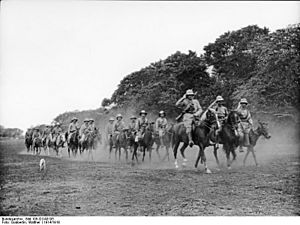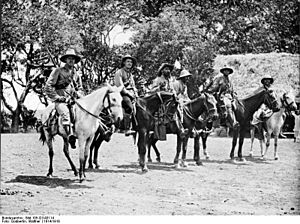Battle of Kilimanjaro facts for kids
Quick facts for kids Battle of Kilimanjaro |
|||||||
|---|---|---|---|---|---|---|---|
| Part of the East African Campaign of World War I | |||||||
 A mounted contingent of the German colonial volunteer 8th Rifle Company, 1914 |
|||||||
|
|||||||
| Belligerents | |||||||
|
|||||||
| Commanders and leaders | |||||||
| Strength | |||||||
| 686 | ~1,500 | ||||||
| Casualties and losses | |||||||
| 109 | 312 | ||||||
The Battle of Kilimanjaro happened in November 1914. It took place in a place called Longido, which was part of German East Africa. This battle was one of the first fights in the East African Campaign during World War I.
Contents
What Led to the Battle?
The British wanted to take over German East Africa. They planned a two-part attack. One attack would be on the port of Tanga. The other would be on Longido, near Mount Kilimanjaro.
The British Plan
Major General Arthur Aitken was in charge of the whole plan. The main attack was aimed at Tanga. This force, called the British Indian Expeditionary Force "B", had about 8,000 soldiers.
The second attack was planned for Longido. This area was in the north, close to Mount Kilimanjaro. The goal was to then move south and capture Neu Moshi. This town was at the end of the Usambara or Northern Railroad. The idea was to trap the German forces in a pincer movement.
Why Attack Kilimanjaro?
The Kilimanjaro region was important to the Germans. They had many farms there growing sisal and coffee. Small German groups had already started attacking British areas. They even attacked the Uganda Railway. So, getting rid of German forces near British East Africa was a key goal.
British and German Forces
By late October 1914, the British Indian Expeditionary Force "C" gathered. They had 4,000 soldiers. Brigadier General J. M. Stewart led this group. It included local volunteers called the East Africa Mounted Rifles.
The British thought the Germans only had about 200 soldiers. But this was wrong. The Germans actually had 600 askaris (African soldiers). They also had 86 young German volunteers on horseback. These volunteers were part of the 8th Schützenkompagnie (rifle company).
The Battle Begins
On November 3, 1914, about 1,500 Punjabi soldiers from the British force moved up the slope near Longido. It was night, and in the morning fog, they were caught. The Germans had strong defenses and fired from different directions.
Fighting and Casualties
The Indian soldiers fought well when the Germans attacked them. However, the British attackers could not move forward. They suffered many losses.
By mid-morning, German horsemen ambushed a British supply group. They were from the 8th Rifle Company. About 100 mules carrying water for the troops were scared away. Some of the carriers panicked and dropped their supplies. They left behind food, ammunition, and equipment.
British Retreat
The British officers and their scattered troops waited until it was dark. They realized their situation was very bad. They decided to leave the mountain. They marched back to British East Africa. They had not achieved anything. This defeat made many British volunteers less excited about the war.
What Happened Next?
The attack at Longido was meant to be a distraction. The main British effort was a big attack on the port of Tanga. That attack started on November 2, 1914.
After the Longido battle, the German askari companies were sent by train to Tanga. They went to help fight against the British attack there.
See also


